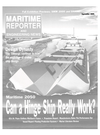
Page 56: of Maritime Reporter Magazine (September 2000)
Read this page in Pdf, Flash or Html5 edition of September 2000 Maritime Reporter Magazine
Vessel Focus: FPSO
FPSO Retrofit Design Accelerated With CAD
Software that automatically produces loop, cable, and termination drawings from information in piping and instru- mentation diagrams (P&IDs) allowed
Merpro Limited to prepare electrical schematics for an offshore retrofit twice as fast as on previous projects. The retrofit involved a floating production storage and offloading (FPSO) tanker, the Bluewater Uisge Gorm, which was increasing the water cut and accumulat- ing solids in one of its separators. Mer- pro designed a system that addressed both problems. The documentation for the system included 78 electrical schematics, and in a time and cost-sav- ing move designers created "intelligent"
P&IDs containing equipment specifica-
The Mooring Specialists
Chain Hawser Hooks Chain Stoppers SPM Load Monitoring
Quick release under full load
Loads to 450 tonnes SWL
Remote release
Load monitoring
Designed for class 1 zone 1
Designed to OCIMF guidelines
Approvals to Lloyds, ABS, DNV.
Quick release under full load
Working load to 650 tonnes
Chain sizes to 110 dia
Load monitoring
Remote release
Deck mounted installation
Load data transmitted by radio telemetry - to base station - to portable monitor on vessel
Visual and audible alarms
Dual gauged load cells
Double sealed electronics
For class I zone I areas
Trouble shooting by remote modem access
Harbour & Marine
Engineering F [ PTY LTD 79 Asling St. Brighton, Melbourne, Australia. 3186. Phone: +61 3 9530 6333
Fax: + 61 3 9530 6366. Email: [email protected]
Web: http://www.harbourmarine.com
Circle 324 on Reader Service Card
Simplan® Face Seals
Optimal sealing properties for water-lubricated sterntubes
Simplex-Turmar, Inc.
P.O. Box 675, Tonawanda, NY 14151-0675 U.S.A.
Call Toll Free: 888-357-3257
Fax: 716-695-0144
Email: [email protected]
Website: www.simplex-turmar.com
B+V Industrietechnik tions, engineering information, and other data. Then they created loop and junction box templates using the soft- ware's drafting system. The prototypes used "tokens" to represent information such as tag number, manufacturer, model number, and so on. The software automatically generated loop, cable, and termination drawings by replacing tokens with descriptive data from the
P&ID instrument index master data- base, making it possible to complete the drawings in six weeks.
The Uisge Gorm is situated on the
Furgus Fife Oil Field in the U.K. sector of the North Sea, close to the Norwegian and Danish sectors. During the initial two years operation, being a marginal field the water cut increased quite dra- matically such that the field was produc- ing almost as much water as oil and this would continue to increase as the age of the field increased. The high water cut meant that the produced water system was running near its limit and as such to achieve the oil in water overboard dis- charge legislative requirements produc- tion had to be cut back, this would result in a decrease in revenue. A second problem, one of sand production, was also encountered during this period with plant shut downs having to take place at more frequent intervals to remove the solids build up in the separation vessels.
Besides the more frequent shutdowns to remove the solids, a potentially greater problem is the effect that sand has on the instrumentation and the erosive effects on pipework and valves. The existing plant like most installations in the North
Sea had no facility to manage solids.
Merpro Limited was contracted by
Bluewater Engineering b.v. to design a system to meet the above needs.
Merpro specializes in the design and manufacture of oil and gas processing systems primarily for the offshore sector a two-part solution was proposed for the
Usige Gorm. In the past, Merpro would have generated the documentation for a project such as this by using one pro- gram to create P&IDs, AutoCAD to cre- ate electrical schematics such as junc- tion box layouts and instrumentation loops, and a spreadsheet application to generate instrument and valve lists.
Since there was no connection between any of the programs, each schematic was started from scratch and equipment lists were created manually on spread-
Circle 278 on Reader Service Card Circle 243 on Reader Service Card Circle 230 on Reader Service Card

 55
55

 57
57
